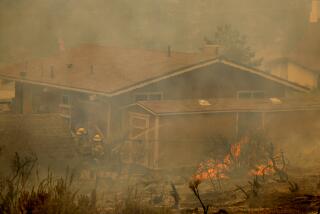Fire Prescribed to Cure Ailing Forest : Environment: A policy of battling flames has left a sick ecosystem. Now a U.S. agency plans to allow natural blazes in the right place at the right time.
LA GRANDE, Ore. — For generations, Smokey Bear has admonished Americans not to start forest fires. Now, the U.S. Forest Service is planning to bring fire back to some forests where it has been kept out too long.
In the Blue Mountains of northeastern Oregon, for example, a tradition of fighting forest fires has backfired, leaving a sick ecosystem where hordes of insects feast on weakened trees. Half the woods have turned to brown, and fires are a greater danger than ever.
“We have a public, a national public, that has been given the message that Smokey and all his friends get their homes burned up and get killed from fires,” said Charles G. Johnson Jr., a Forest Service ecologist who helped write the prescription for nursing the Blue Mountains back to health.
“If we don’t create them in our time frame on our scale, Mother Nature will provide them for us, and it may be on a scale and time frame we don’t like.”
That’s what happened at Yellowstone National Park. Years of fighting fire allowed deadwood to build up like logs in a fireplace. To return balance to the forest, the National Park Service decided in 1972 to let lightning fires burn, as long as they didn’t threaten people or buildings.
But the stage was already set. When the summer of 1988 came in hot, dry and windy, there was little anyone could do but get out of the way as flames roared through nearly 800,000 acres of the 2.2-million-acre park.
The biggest of the fires was sparked at a logging site outside the park and was fought from the beginning, said park spokeswoman Joan Anzelmo.
But public outrage forced the Park Service to reconsider its fire policy, anyway. Now the agency proposes to still allow natural fires, provided that they are in the right place at the right time.
Around the country, people are realizing that fire is good, said Jack Walstad, chairman of Oregon State University’s Department of Forest Resources. He is organizing a symposium on fire in the forest in January.
“As we learned at Yellowstone, it is impossible to exclude fire for indefinite periods of time,” Walstad said. “If we are going to maintain and restore health and vigor to ecosystems, we are going to have to learn how to use fire intelligently.”
To that end, the Forest Service is looking at carefully restoring fire to places such as the Blue Mountains.
“Whether Smokey begins to carry a drip torch, I don’t think that’s the Forest Service’s intention,” said Thomas Quigley, a Forest Service range scientist who heads the Blue Mountains Institute. “But the Forest Service does have a fair amount of support internally now to see fire management take a more dominant role in the sorts of ecosystems we have in the Blue Mountains.”
When covered wagons rolled through the Blue Mountains on the Oregon Trail, pioneers saw open stands of big ponderosa pine, with a blue pall of smoke that gave the region its name. The smoke came from slow-burning fires that hop-scotched around the mountains every 10 to 20 years, clearing out fir seedlings that sprouted in the shade of the pines, which were protected by thick bark.
As settlement grew, people put out the fires, allowing Douglas fir, white fir and grand fir to crowd in.
“They’ve been keeping fire out of here since 1914,” said Jim Barrett, a Forest Service silviculturist, or expert in forest cultivation. “The fir has come in and is now weakened by drought and just groceries for the budworm.”
Despite its name, the spruce budworm has a sweet tooth for fir, and since 1983, the Blue Mountains have been its candy store. The insect larva eats the new needles, weakening and eventually killing the tree. Like sharks drawn to blood, a half-dozen other pests have moved in.
When Barrett beat at the branches of one Douglas fir, scores of spruce budworms fell out.
“The outbreak we are seeing today is probably the worst anybody can remember,” said Dick Mason, a Forest Service entomologist. “It may be playing the same kind of role that fire would have done if fire had been allowed to burn in a normal sequence. You get too much of one thing, something else comes in and knocks it back again. All these things are in balance.”
The Forest Service still fights all wildfires, because they are destructive and dangerous.
But foresters plan more prescribed fires in spring and fall, when they burn slowly, rejuvenate the forest, and consume deadwood, he said. Plans are being written to let lightning strikes burn in the Eagle Cap Wilderness if they meet prescribed conditions. Some logging will be done to simulate the effects of fire.
Greear said Smokey Bear’s message is no longer the one-dimensional “Only you can prevent forest fires.”
“Smokey is probably also saying, ‘I sure hope somebody up there has a prescribed fire on this hillside so I’ll get some huckleberries back.’ ”
More to Read
Sign up for Essential California
The most important California stories and recommendations in your inbox every morning.
You may occasionally receive promotional content from the Los Angeles Times.










